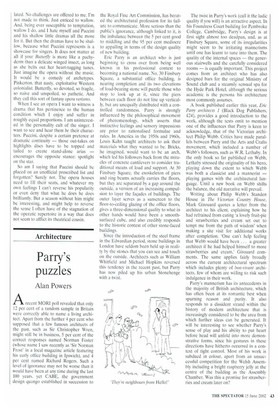Parry's puzzles
Alan Powers
Arecent MORI poll revealed that only 12 per cent of a random sample in Britain were correctly able to name a living architect. Apart from the further 4 per cent who supposed that a few famous architects of the past, such as Sir Christopher Wren, might still be in business, 5 per cent of the correct responses named Norman Foster (whose name I saw recently as 'Sir Norman Frost' in a local magazine article featuring his early office building in Ipswich), and 4 per cent named Richard Rogers. Such a level of ignorance may not be worse than it would have been at any time during the last 100 years. yet CABE, the government design quango established in succession to
the Royal Fine Art Commission, has berated the architectural profession for its failure to communicate. More serious than the public's ignorance, although linked to it, is the imbalance between the 5 per cent good to middling and the 95 per cent mediocre to appalling in terms of the design quality of new building.
Eric Parry is an architect who is just beginning to cross over from being well known in his professional context to becoming a national name. No. 30 Finsbury Square, a substantial office building, is nearing completion and its two elevations of load-bearing stone will puzzle those who stop to look up at it, since the piers between each floor do not line up vertically, but are unequally distributed with a controlled randomness. Parry is strongly influenced by the philosophical movement of phenomenology, which asserts that instinctive feelings and sensory impressions are prior to rationalised formulae and rules. In America in the 1950s and 1960s, Louis Kahn taught architects to ask their materials what they wanted to be. Bricks, he imagined, would want to be an arch, which led his followers back from the miracles of concrete cantilevers to consider traditional means of load and support. At 30 Finsbury Square, the exoskeleton of piers and ring beams actually carries the floors, but they are separated by a gap around the outside, a version of an increasing compulsion to layer the façades of buildings. The outer layer serves as a sunscreen to the floor-to-ceiling glazing of the office floors, gives a three-dimensional quality to what in other hands would have been a smoothsurfaced cube, and also credibly responds to the historic context of other stone-faced buildings.
Since the introduction of the steel frame in the Edwardian period, stone buildings in London have seldom been held up in reality by the stones that you can see and touch on the outside. Architects such as William Whitfield and Michael Hopkins reversed this tendency in the recent past, but Parry has now piled up his urban Stonehenge with a twist. The twist in Parry's work (call it the ludic quality if you will) is an attractive aspect. In his Foundress Court building for Pembroke College, Cambridge, Parry's design is at first sight almost too deadpan, and, as at Finsbury Square, some of its irregularities might seem to be irritating mannerisms until one has learnt to tune into them. The quality of the internal spaces — the generous stairwells and the carefully considered rooms — is equally important. This project comes from an architect who has also designed bars for the original Ministry of Sound club and a steamily sensual spa for the Hyde Park Hotel, although the serious academic is the persona his architecture most commonly assumes.
A book published earlier this year, Eric Parry architects I (Black Dog Publishers, £24), provides a good introduction to the work, although the texts omit to mention one of the influences that Parry is keen to acknowledge, that of the Victorian architect Philip Webb. Critics have made parallels between Parry and the Arts and Crafts movement, which included a number of WeWs followers, such as W.R. Lethaby. In the only book so far published on Webb, Lethaby stressed the originality of his hero, playing down the extent to which Webb was both a classicist and a mannerist — playing games with the architectural language. Until a new book on Webb shifts the balance, the old narrative will prevail.
Writing about Philip Webb's Standen House in The Victorian Country, House, Mark Girouard quotes a letter from the architect to his client, explaining how he had refrained from eating 'a lovely fruit-pie and strawberries and cream set out to tempt me from the path of wisdom' when making a site visit for additional works after completion. One can't help feeling that Webb would have been ... a greater architect if he had helped himself to more strawberries and cream,' Girouard comments. The same applies fairly broadly across the current architectural spectrum which includes plenty of bon-vivant architects, few of whom are willing to risk such indulgence in their work.
Parry's mannerism has its antecedents in the majority of British architecture, which has often been at its romantic best when spurning reason and purity. It also responds to a dissident strand within the history of modern architecture that is increasingly considered to be the area from which further ideas can be generated. It will be interesting to see whether Parry's sense of play and his ability to put heart before head will unfold into more demonstrative forms, since his gestures in these directions have hitherto occurred in a context of tight control. Most of his work is subdued in colour, apart from an unsuccessful competition for the Welsh Assembly including a bright raspberry jelly at the centre of the building as the Assembly Chamber. Was this a promise for strawberries and cream later on?


































































 Previous page
Previous page